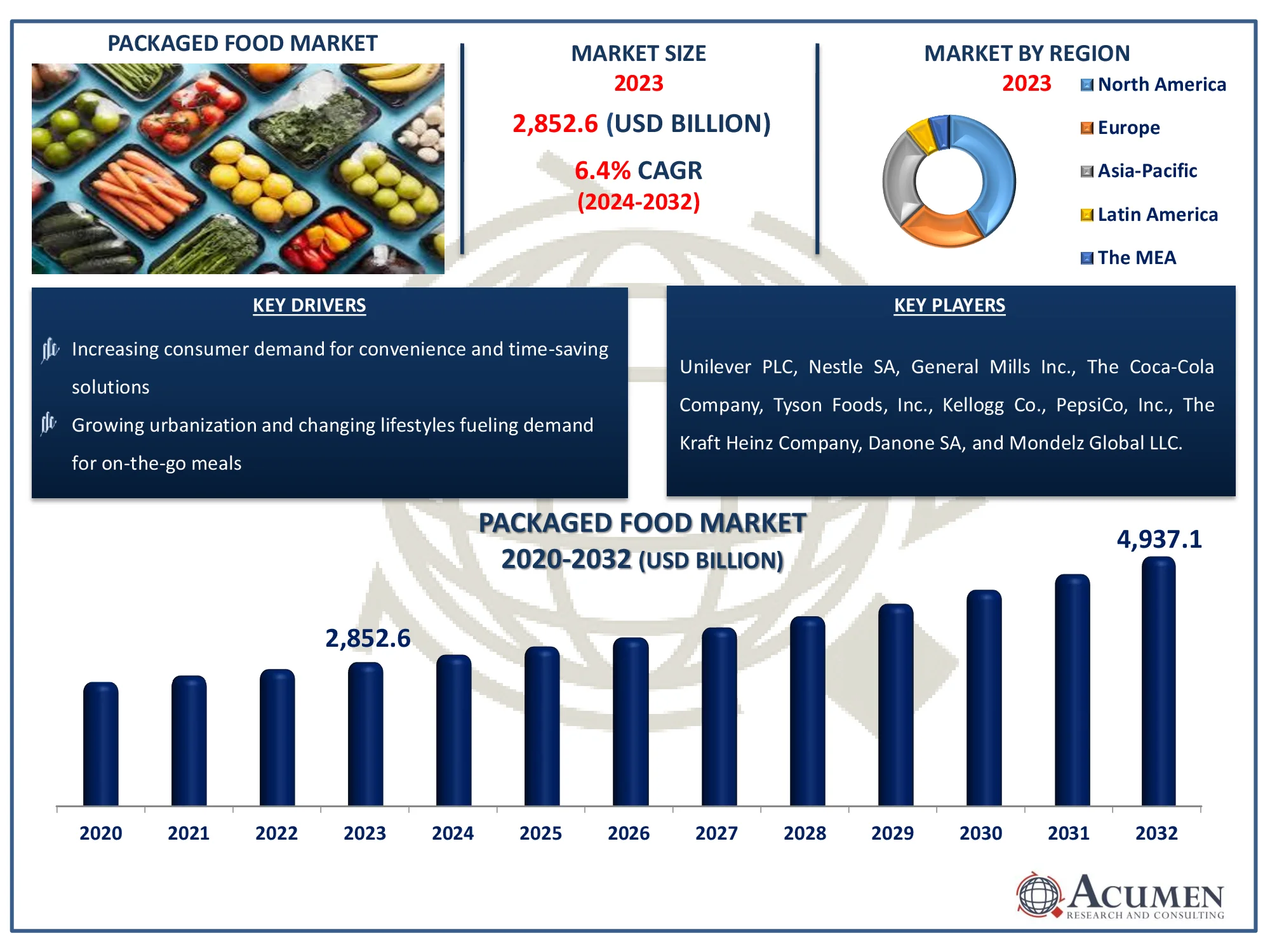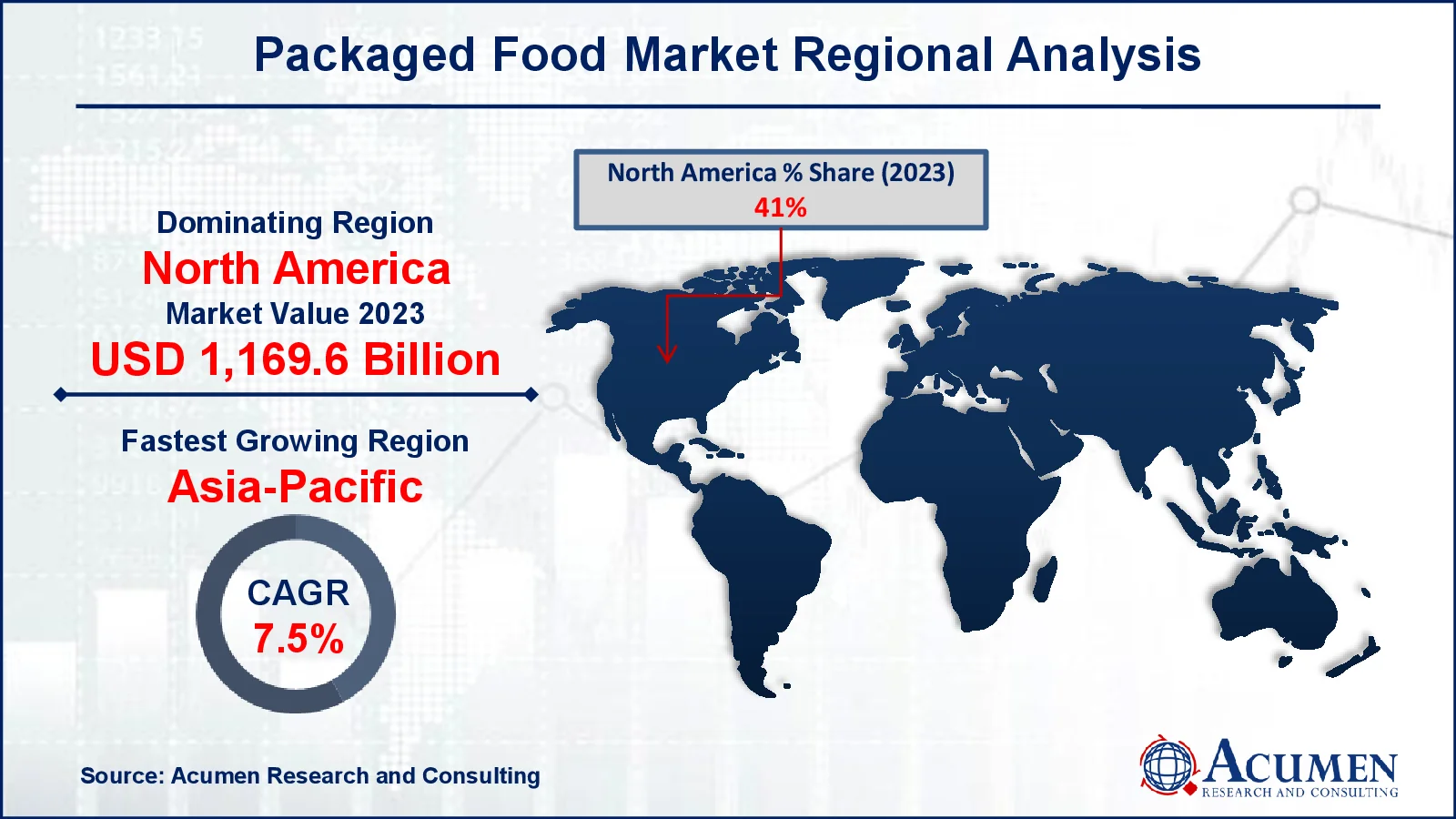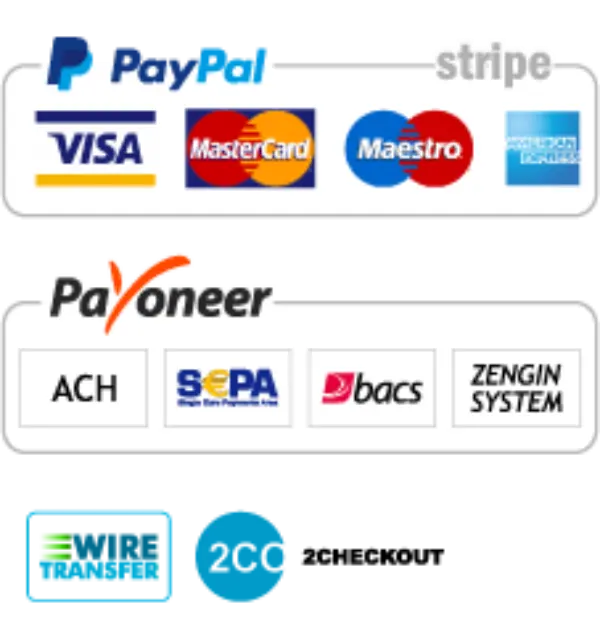Packaged Food Market Size - Global Industry Analysis, Share, Analysis, Trends and Forecast 2024 - 2032
Published :
Report ID:
Pages :
Format :
Packaged Food Market Size - Global Industry Analysis, Share, Analysis, Trends and Forecast 2024 - 2032
Report Coverage
- Industry Dynamics
- Market Size and Forecast Data
- Segment Analysis
- Competitive Landscape
- Regional Analysis with a Niche Focus on Country-Level Data
- High Level Analysis - Porter's, PESTEL, Value Chain, etc.
- Company Profiles of Key Players
- Option to Customize the Report As Per Your Specific Need
Request Sample Report
The Global Packaged Food Market Size accounted for USD 2,852.6 Billion in 2022 and is estimated to achieve a market size of USD 4,937.1 Billion by 2032 growing at a CAGR of 6.4% from 2024 to 2032.
Packaged Food Market Highlights
- Global packaged food market revenue is poised to garner USD 4,937.1 billion by 2032 with a CAGR of 6.4% from 2024 to 2032
- North America packaged food market value occupied around USD 1,169.6 billion in 2022
- Asia-Pacific packaged food market growth will record a CAGR of more than 7.5% from 2024 to 2032
- Among type, the beverage sub-segment generated USD 513.5 billion revenue in 2022
- Based on sales channel, the supermarket/hypermarket sub-segment generated 65% packaged food market share in 2022
- Increasing demand for organic, natural, and functional packaged food options is a popular packaged food market trend that fuels the industry demand

Packaged food is defined as any food item that has been produced, sealed, and kept in packaging before reaching customers. These items are processed at different stages, such as cooking, freezing, drying, or canning, to extend their shelf life and provide convenience. They cover a wide range of products, including canned foods, frozen meals, snacks, cereals, and drinks. Packaging not only protects the food but also offers information about the contents, nutritional value, and expiration dates. While packaged meals are convenient and easy to use, they can also include preservatives, additives, and high quantities of salt, sugar, or fat, which can be harmful to one's health if taken in excess. Therefore, it's important to combine convenience with nutritional awareness when introducing packaged foods into one's diet.
Global Packaged Food Market Dynamics
Market Drivers
- Increasing consumer demand for convenience and time-saving solutions
- Growing urbanization and changing lifestyles fueling demand for on-the-go meals
- Technological advancements enhancing food preservation and packaging techniques
- Rising disposable incomes leading to higher spending on packaged food products
Market Restraints
- Concerns regarding the health implications of processed and packaged foods
- Stringent regulations on labeling and food safety standards
- Environmental concerns related to packaging waste and sustainability
Market Opportunities
- Expansion into emerging markets with rising disposable incomes and changing consumption patterns
- Innovation in healthier and more sustainable packaging solutions
- Growth in e-commerce channels providing wider reach and accessibility
Packaged Food Market Report Coverage
|
Market |
Packaged Food Market |
|
Packaged Food Market Size 2022 |
USD 2,852.6 Billion |
|
Packaged Food Market Forecast 2032 |
USD 4,937.1 Billion |
|
Packaged Food Market CAGR During 2024 - 2032 |
6.4% |
|
Packaged Food Market Analysis Period |
2020 - 2032 |
|
Packaged Food Market Base Year |
2022 |
|
Packaged Food Market Forecast Data |
2024 - 2032 |
|
Segments Covered |
By Type, By Sales Channel, and By Geography |
|
Regional Scope |
North America, Europe, Asia Pacific, Latin America, and Middle East & Africa |
|
Key Companies Profiled |
Unilever PLC, Nestle SA, General Mills Inc., The Coca-Cola Company, Tyson Foods, Inc., Kellogg Co., PepsiCo, Inc., The Kraft Heinz Company, Danone SA, and Mondelz Global LLC. |
|
Report Coverage |
Market Trends, Drivers, Restraints, Competitive Analysis, Player Profiling, Covid-19 Analysis, Regulation Analysis |
Packaged Food Market Insights
Growing urbanization and changing lifestyles have resulted in an increase in demand for on-the-go meals, boosting the packaged food sector. As cities grow and people's lives get busier, they seek for easy eating alternatives that fit into their hectic schedules. Ready-to-eat snacks, microwaveable meals, and single-serve portions meet this demand by providing quick and convenient food. Furthermore, urban inhabitants sometimes lack the time or resources to prepare complex meals, increasing their demand for packaged convenience foods. This development reflects a cultural change towards convenience-oriented consumption behaviours, making packaged food an essential component of modern city living.
Stringent laws controlling labeling and food safety requirements present substantial obstacles to the packaged food industry. Governments throughout the world set tight requirements to protect consumer safety and openness in product labeling. Compliance with these laws necessitates significant investment in testing, documentation, and quality control methods, raising operational expenses for producers. Furthermore, failing to satisfy these requirements can result in legal consequences, harm brand reputation, and lose customer trust. As a result, firms in the packaged food market must priorities regulatory compliance and invest in strong quality assurance systems to reduce risks and preserve customer trust.
Innovation in healthier and more sustainable packaging options is a great opportunity for the packaged food industry. With rising environmental awareness and worries about plastic waste, customers are increasingly looking for eco-friendly packaging choices. Manufacturers are reacting by experimenting with new materials and technology to create packaging solutions that are both sustainable and practical. From biodegradable plastics to compostable packaging and reusable containers, the industry is embracing a paradigm shift towards greener options. Furthermore, package innovations provide potential for improving product distinction, brand image, and customer appeal. Companies who embrace sustainability in packaging not only lower their environmental footprint, but also get access to a rising market segment of eco-conscious customers, creating growth and competitive advantage in the packaged food business.
 Packaged Food Market Segmentation
Packaged Food Market Segmentation
The worldwide market for packaged food is split based on type, sales channel, and geography.
Packaged Food Types
- Dairy Products
- Confectionery
- Beverage
- Bakery
- Snacks
- Meat, Poultry and Seafood
- Breakfast Cereals
- Ready Meals
- Others
According to packaged food industry analysis, there is an increasing consumer desire for convenience and on-the-go consumption, which is driving up demand for packaged beverages that are portable and easy to consume. With hectic lifestyles becoming the norm, ready-to-drink drinks provide a quick and simple way to stay hydrated and refreshed. Second, people are becoming more mindful of health and wellbeing, which is increasing demand for better beverage alternatives. This covers items like functional beverages, natural fruit juices, herbal teas, and low-calorie drinks. Health-conscious customers are actively looking for beverages that provide nutritional advantages, such as vitamins, minerals, and antioxidants, without sacrificing flavour.
Plus, unique product compositions and flavour variants are generating customer interest and growing the beverage industry. Manufacturers are always launching new and distinctive beverage choices, such as exotic fruit flavours, plant-based alternatives, and artisanal drinks, to appeal to a wide range of consumer preferences and tastes.nFurthermore, aggressive marketing efforts, product variety, and distribution channel development are helping to drive growth in the beverage category. Companies use digital platforms, social media, and influencer marketing to successfully promote their beverage goods and communicate with customers.
Packaged Food Sales Channels
- Retail Stores
- Convenience Stores
- Supermarket/Hypermarket
- E-commerce
Supermarkets and hypermarkets dominate the packaged food sector due to their broad popularity. These retail behemoths provide unrivalled convenience and choice, providing a diverse selection of packaged food goods under one roof. With ample floor area, they can accommodate a wide range of customer preferences, allowing consumers to find everything they need in one spot. Moreover, their large-scale operations allow them to negotiate competitive prices with suppliers, making packaged meals more affordable for budget-conscious customers. Strategic marketing and promotional initiatives, such as eye-catching displays and appealing promos, add to their attractiveness by providing an engaging shopping experience that stimulates purchases.
In addition to a wide range of items, supermarkets and hypermarkets prioritise customer happiness by offering self-checkout choices, reward programmes, and in-store eating facilities. This emphasis on improving the complete shopping experience promotes consumer loyalty and encourages return visits. Also, modern customers' fast-paced lifestyles favour the convenience of supermarket and hypermarket shopping, which allows them to meet all of their packaged food demands effectively in one location. This congruence with customer tastes strengthens the supermarket/hypermarket segment's position as the most important sales channel in the packaged food market.
Packaged Food Market Regional Outlook
North America
- U.S.
- Canada
Europe
- U.K.
- Germany
- France
- Spain
- Rest of Europe
Asia-Pacific
- India
- Japan
- China
- Australia
- South Korea
- Rest of Asia-Pacific
Latin America
- Brazil
- Mexico
- Rest of LATAM
The Middle East & Africa
- South Africa
- GCC Countries
- Rest of the Middle East & Africa (ME&A)

Packaged Food Market Regional Analysis
In terms of packaged food market analysis, in 2023, North America held a considerable market share and is anticipated to continue expanding healthily due to emerging currencies, ease of ordering, new consumer patterns, and significant investments by local players aimed at achieving greater performance. The retail processed food industry, driven by large sales in the US and Canada, forms a significant part of North America's market. Consumers in these countries often opt for ready-to-eat food packets instead of regular meals due to their busy schedules. Despite the strong popularity of staple food goods, the demand for processed foods continues to rise. Another contributing factor to the North American market's growth is that food manufacturers are updating their product categories to include both snack foods and safe packaged foods.
Packaged Food Market Players
Some of the top packaged food companies offered in our report include Unilever PLC, Nestle SA, General Mills Inc., The Coca-Cola Company, Tyson Foods, Inc., Kellogg Co., PepsiCo, Inc., The Kraft Heinz Company, Danone SA, and Mondelz Global LLC.
Frequently Asked Questions
How big is the packaged food market?
The packaged food market size was valued at USD 2,852.6 Billion in 2023.
What is the CAGR of the global packaged food market from 2024 to 2032?
The CAGR of packaged food is 6.4% during the analysis period of 2024 to 2032.
Which are the key players in the packaged food market?
The key players operating in the global market are including Unilever PLC, Nestle SA, General Mills Inc., The Coca-Cola Company, Tyson Foods, Inc., Kellogg Co., PepsiCo, Inc., The Kraft Heinz Company, Danone SA, and Mondelz Global LLC.
Which region dominated the global packaged food market share?
North America held the dominating position in packaged food industry during the analysis period of 2024 to 2032.
Which region registered fastest CAGR from 2024 to 2032?
Asia-Pacific region exhibited fastest growing CAGR for market of packaged food during the analysis period of 2024 to 2032.
What are the current trends and dynamics in the global packaged food industry?
The current trends and dynamics in the packaged food industry include increasing consumer demand for convenience and time-saving solutions, growing urbanization and changing lifestyles fueling demand for on-the-go meals, technological advancements enhancing food preservation and packaging techniques, and rising disposable incomes leading to higher spending on packaged food products.
Which sales channel held the maximum share in 2022?
The supermarket/hypermarket sales channel held the maximum share of the packaged food industry.


